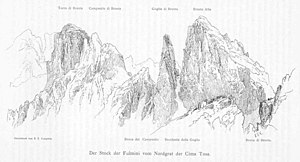Torre di Brenta
| Torre di Brenta | ||
|---|---|---|
|
The Sfulmini chain seen from the west, drawing by ET Compton |
||
| height | 3014 m slm | |
| location | Trentino , Italy | |
| Mountains | Brenta Group | |
| Notch height | 285 m ↓ Bocchetta di Molveno | |
| Coordinates | 46 ° 10 '4 " N , 10 ° 53' 45" E | |
|
|
||
| Type | Felsberg | |
| rock | Main dolomite | |
| First ascent | June 24, 1882 by the English painter and alpinist Edward Theodore Compton and the Italian mountain guide Matteo Nicolussi from Molveno | |
| Normal way | from the Alimontahütte over the Bocca degli Armi, the Vedretta dei Sfulmini over the north side | |
The Torre di Brenta (Italian: Torre , tower) is a 3,014 meter high mountain in the Brenta Group , a mountain range in the southern Limestone Alps in the Italian province of Trento . It belongs to the so-called Sfulmini group , a series of needle- shaped or tower-shaped rock peaks that extend in a north-south direction. To the west, the Val Brenta ( Brenta ) out dominated the Torre di Brenta the area by their impressive north-western wall, which rises 500 meters above the valley. Like all the peaks of the Brenta, the Torre is made of solid main dolomite rock, which makes it an attractive destination for climbers in particular , so numerous routes lead to the summit. Was first climbed the mountain on 24 June 1882 by the English artist and mountaineer Edward Theodore Compton and the Italian mountain guide Matteo Nicolussi from Molveno from the north on the glacier Vedretta dei Sfulmini .
geology
See: Crozzon di Brenta
Surroundings
The Torre di Brenta is located in the Sfulmini mountain range , which is bordered in the south by the Bocca di Brenta crossing (altitude 2549 m) and in the north by the Bocchetta di Molveno , at an altitude of 2746 meters. The highest neighboring mountain in the south is the 2960 meter high Cima Brenta Alta in a northerly direction follows the Campanile Alto (2937 m), some more rocky peaks and north of the Torre are the Cima dei Armi (2949 m) and finally the 2915 meter high Cima Molveno . North of the Torre di Brenta, the Vedretta dei Sfulmini glacier, which is in the process of melting due to global warming, extends to an altitude of 2750 meters. To the north the area rises to the Cima Brenta to heights of over 3000 meters, to the east it drops into the Val delle Seghe , to the south into the Val d'Ambiéz and to the west into the Val Brenta. Nearest towns are in the northwest, the well 7.5 km in a straight line away Madonna di Campiglio in Campigliotal , in the southeast, the about 6.5 km away is Molveno on Lake Molveno and about 12 km to the south, San Lorenzo in Banale .
First ascent, bases and routes
Compton and Nicolussi set out from Rifugio Tosa ( Tosahütte , 2442 m) on June 26th, 1882 at 12 noon , the same day they had conquered Cima Tosa . The two went north up to the Bocca degli Armi and the Vedretta dei Sfulmini. Via the north side, they reached the summit after more than four hours, sometimes with arduous climbing.
Today's normal route , the easiest ascent, also follows the Compton and Nicolussis route. The starting point is the Rifugio Angelo Alimonta at an altitude of 2600 meters. First the path leads up to the Bocca degli Armi and the glacier. The entrance is on one of the rock bands characteristic of the Brenta. Then it goes in partly easy climbing with difficulty UIAA II through chimneys, a crack and through a window in the rock on the west side of the Torre and finally over the west ridge to the summit. Numerous serious climbing routes have been opened since 1896 through the north face and over the east ridge in today's UIAA grade III +, since the 1930s people have climbed in IV. To VI. Grad through the southwest face and in 1963 Harris and Mortlock finally climbed the so-called mistaken route in UIAA grade VI.
Literature and map
- Karl Schulz in Eduard Richter (ed.): The development of the Eastern Alps , III. Volume, Berlin 1894
- Heinz Steinkötter: Alpine Club Leader Brenta Group , Munich 1988, ISBN 3-7633-1311-7
- Alpine Club Map 1: 25,000, sheet 51, Brenta group
Individual evidence
- ^ Edward Theodore Compton in: Journal of the German and Austrian Alpine Association , Volume XV, Munich 1884, p. 194 ff.
- ^ Heinz Steinkötter, Alpine Club Leader Brenta Group , Munich 1988
Web links
- Torre di Brenta on summitpost.org (English)

